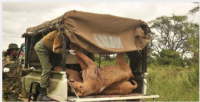News
Latest Lion Aid News
Six lions killed outside Nairobi National Park
Saturday 23rd June 2012
 Over the last few days, there has been a tremendous amount of attention paid on the internet and the internationa media about six lions killed by farmers just outside Nairobi National Park. The killing of those lions (2 adult females, two subadults, and two cubs) is of course regrettable and tragic, but perhaps predictable. It appears that the lions broke into a boma (a fenced area where livestock are kept at night) at 1am, got trapped, and were killed at 6am – but different versions are rampant. Meanwhile, many goats and perhaps cattle were killed. Blame flies – the Kenya Wildlife Service was too slow to respond, the farmers killed the lions illegally and should be prosecuted, KWS should educate people better about the value of wildlife, the boma was inadequate in a high-risk area, lion movements should be better monitored with radiocollars – but it is also a reflection of predator/livestock/human conflict happening every day in Africa, and needs to be addressed in a meaningful way. And there are solutions, difficult as they might be for some to accept: perhaps it is the management of the Nairobi National Park (NNP) that should be improved in this instance. The NNP was established in 1946. It was the brainchild of Mervyn Cowie, who went on to establish many other National Parks in Uganda and Tanzania. Cowie’s vision was that there should be special areas where wild animals could exist without interference from people, that tourism could generate the revenues needed to establish and maintain the infrastructure, and that national parks could provide a means of protecting wildlife. The British colonial government was not convinced, and it is said Cowie wrote a letter (signed “Old Settler”) in the East African Standard newspaper to advocate the killing of all wildlife to make room for agriculture. The outcry about that letter led to the establishment of the national park (Maasai pastoralists had to be evicted). Nairobi in 1946 was a bit different from Nairobi in 2012. A population estimate in 1948 reported 118,000 residents. Now, there are an estimated 3.3 million. Nairobi is the 13th largest city in Africa, and the urban population grows by the day. The Kibera slum community is the second-largest shantytown in Africa. Nairobi National Park depended for its existence on a connection with the Athi/Kapiti Plains and the Kitengela conservation area to the south. NNP has always been a dry season dispersal area, and the park, only 117 km2 in size, is not an ecological unit that can contain, without significant management, a diverse resident wildlife population. Of course, with Nairobi City pressing in from the north, east and west, and settlements in the south, the park is becoming a little island. A Nairobi bypass road looks like it will soon be constructed near the southern boundary. Small islands are always associated with romanticism, but it is time that NNP faces a big reality. It is an anachronism. It cannot provide protection for the resident carnivore populations unless much more intensively managed – perhaps including fencing. It might be the only wildlife park within sight of a capital city, but that means it really needs to adapt with the times. As it exists, the park cannot hope to conserve predators that regularly move out of the park and prey on livestock. There are now 37 lions left, and within a few years there could well be none unless they are better protected. The park needs to engage better with all stakeholders and accept that because it is unique, innovative new programmes are needed. Perhaps the death of these lions can motivate such changes – otherwise more will surely die. Picture credit: http://bit.ly/LHZaQx Tags: humanwildlife conflict, Nairobi National Park, bomas, Categories: Human/Wildlife Conflict, Population declines |
Add a comment | Posted by Pieter Kat at 15:25



